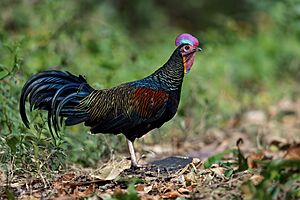Green junglefowl facts for kids
Quick facts for kids Green junglefowl |
|
|---|---|
 |
|
| Conservation status | |
| Scientific classification | |
| Genus: |
Gallus
|
| Species: |
varius
|

|
|
The green junglefowl (Gallus varius), also called the Javan junglefowl, is a medium-sized bird, growing up to 75 cm long. It belongs to the pheasant family, Phasianidae. This bird is special because it's the most different of the four types of junglefowl, having separated from them about 4 million years ago. Sometimes, green junglefowl even breed with domestic chickens, creating a mixed-breed bird.
Contents
What Do They Look Like?
Green junglefowl males and females look very different from each other. This is called being sexually dimorphic.
Male Green Junglefowl
From far away, the male green junglefowl looks dark and blackish. But if you get closer, you'll see his feathers shine with many colors! His back feathers look like gleaming scales, similar to those on an ocellated turkey or green peafowl. Each scale is bright blue at the bottom and changes to gold and bronze-green.
The feathers around his throat are very shiny and can look violet or sky blue depending on the light. His wing feathers are a striking burnt orange with bronze-black centers. The tips of his larger wing feathers are bright yellow.
Like the red junglefowl, his chest and belly are a deep, dark black. Similar to the Sri Lankan junglefowl, the male green junglefowl has bright patches of bare skin on his face. These stand out against the dark red of his face.
He has an ice-blue center in his comb, which is the fleshy growth on top of his head. This comb can turn purple or red towards the top. Below each ear, there's a patch of electric yellow skin. His wattle, the fleshy growth under his chin, is also blue with yellow edges near his throat.
Female Green Junglefowl
The female green junglefowl is mostly brown. She has some green feathers mixed in, but she does not have a comb like the male.
Where Do They Live?
The green junglefowl is only found in Indonesia. You can see them on islands like Java, Bali, Lombok, Komodo, Flores, and Rinca. They also live on smaller islands that connect Java with Flores.
These birds live from sea level up to 2,000 meters high. They prefer warm, wet forests, shrublands, and even farmland near the coast. They have been seen flying between islands in their natural home. There's also a small group of them living wild on the Cocos (Keeling) Islands, where they were introduced by humans.
How Do They Behave?
In the wild, green junglefowl usually live in small groups of two to five birds. A dominant male leads the group. He guides them to find food and water, and then back into the safety of the forest.
At night, the flock sleeps high up in bamboo trees, about 15–20 feet above the ground.
Reproduction and Fighting
During the breeding season, other males who don't have a flock will challenge the dominant males. The two males will clap their wings and crow loudly. They fight each other using their spurs, which are sharp growths on their legs.
Green Junglefowl and Humans
People are working to protect and breed green junglefowl in captivity. This is important because their unique genes are slowly disappearing in the wild. This happens because many people breed them with domestic chickens.
The Bekisar Hybrid
When a green junglefowl breeds with a domestic chicken, they create a mixed-breed bird called a bekisar. The bekisar has become very popular in the East Java province of Indonesia. It's even a mascot for the area! Recent studies have shown that genes from green junglefowl have mixed into domestic chicken populations.
Caring for Green Junglefowl
Green junglefowl kept as pets need warm aviaries with lots of plants and places to hide. This is because they are naturally shy birds. They eat grains, seeds, fruits, and insects, just like they would in the wild. People have kept these birds as pets for a long time because of their beauty and their special calls.
Charles Darwin's Interest
The famous English naturalist and biologist Charles Darwin (1809–1882) was very interested in the mixed-breed birds between green junglefowl and domestic chickens. In the 1800s, these hybrids looked so different from their parents that bird scientists thought they were entirely new species.
Darwin wanted to figure out if they were true hybrids or separate species. This was part of his research into where domestic chickens came from. He believed that all domestic chickens came from a single wild ancestor, the red junglefowl (Gallus gallus).
Status and Conservation
The green junglefowl is listed as "least concern" on the IUCN Red List of Threatened Species. This means that, for now, they are not considered to be in danger of disappearing.




